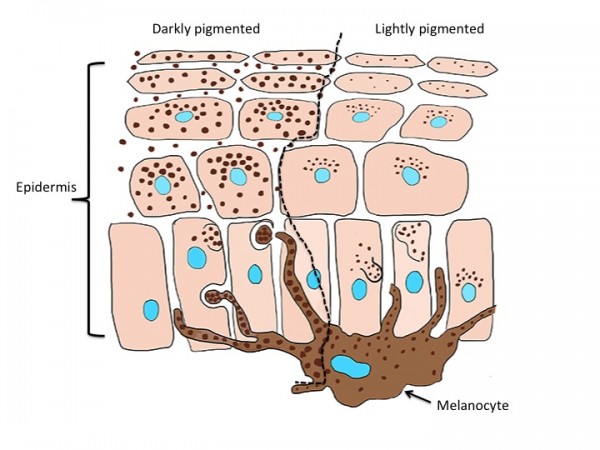How is Pigmented Skin More Acidic?
As we discussed in an earlier post, darkly pigmented skin is superior to lightly pigmented skin. It functions better in holding in body water. It does a better job of preventing skin infections. And it is better at resisting mechanical trauma. We then discussed work from the Elias laboratory demonstrating that this superiority is due to the lower pH of the skin surface. In other words, darkly pigmented skin is more acidic. Yet darkly pigmented skin has the same number of pigment-forming cells (‘melanocytes’) as does lightly colored skin. So, what then is the difference in the melanocytes of darkly- vs. lightly-pigmented skin? Well, one big difference is in the the clusters of pigment (or ‘melanin granules’) made by melanocytes in darkly pigmented skin. They are larger and more numerous than the sparser and smaller melanin granules made by pale skin. Melanocytes transfer these granules to the cytoplasm of neighboring epidermal cells (‘keratinocytes’) using their long arms (or ‘dendrites’). This transfer process happens in both light and dark skin, but here’s where things proceed differently.

The small, crumbly (read ‘crummy’, if you wish) pigment granules of very lightly pigmented skin are degraded within the keratinocytes well before they can reach the outermost layers of the epidermis. In contrast, the larger, more robust melanin granules of darkly-pigmented skin persist within cells as they mature and move outward towards the skin surface. These granules in dark skin are eventually released from epidermal cells far out in epidermis. Importantly, granule release occurs precisely at the same place where the epidermis becomes more acidic in darkly pigmented skin.
As we described in an earlier post, it is this greater skin surface acidity of darkly pigmented individuals that appears to account for their superior epidermal functions. Although it is still unproven, it is likely that melanin granule-containing organelles are highly-acidic. If so, as they are degraded, they release their acidic contents at just the right place to influence these important skin functions. Yet, the story of darkly-pigmented skin may be a bit more complex than just generating more acidity, because the melanocytes of darker skin appear to send out signals that stimulate the epidermis to produce more of the proteins, lipids and enzymes that are important for generating a good barrier. While we do not yet know which signals these melanocytes are sending to the epidermis, it seems clear that both the melanin granules and melanocytes confer many benefits on darkly-pigmented skin beyond their ability to shield the skin from sunlight.
Leave a Reply